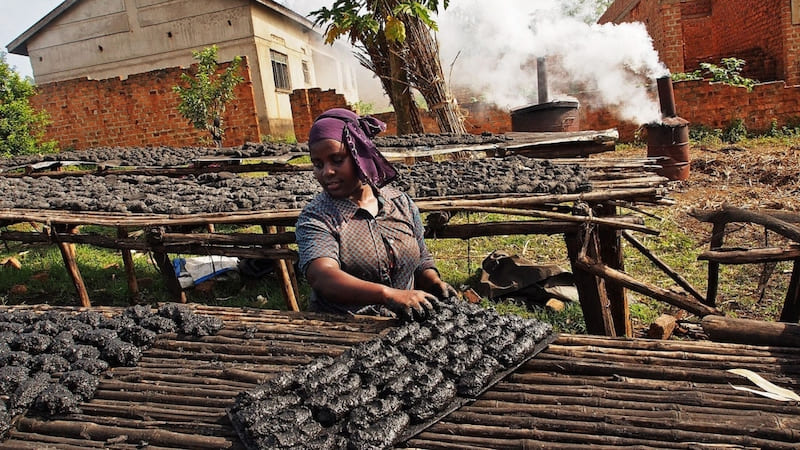
Biochar has a rich history that dates back thousands of years. Its origins can be traced to ancient cultures in the Amazon Basin of South America, where it was known as "Terra Preta" or black earth. It was produced and added to the highly weathered, nutrient-poor tropical soils by pre-Columbian civilizations, leading to pockets of remarkably carbon-rich soils that are amazingly fertile today.
Terra Preta is characterized by its high charcoal content, which led scientists to the discovery and understanding of biochar. The presence of this black earth significantly improved the otherwise infertile Amazonian soil, enhancing its nutrient and moisture retention capacities.
This led to a transformation of agriculture that allowed early agrarian culture to thrive. These Amazon basin soils have maintained their fertility for thousands of years and as productive today as they were then. The addition of biochar to infertile soil shows the learning capability and inventiveness of these ancient civilizations indicating a deep understanding of their environment and enhancement agriculture practices.
The potential of biochar remained largely untapped until its rediscovery in the late 20th century when soil scientists studying Terra Preta started to understand its significance for plant growth in the early 1990s. Researchers also soon discovered its potential for carbon sequestration, and with the growing concern over climate change, biochar started gaining attention worldwide.
By the early 21st century, the study of biochar experienced a renaissance. Scientific communities began exploring biochar’s potential beyond soil amendment, focusing on its ability to combat climate change by sequestering carbon. The concept of pyrolysis was perfected, where organic waste is heated in a low-oxygen environment to produce biochar.

Modern biochar referred to as “green charcoal" by the sustainable agriculture community, is obtained from the pyrolysis of organic biomass such as wood waste, under high-temperature and low-oxygen conditions.
This renewable resource harnesses the energy stored in waste material and converts it into a valuable soil amendment product. Green charcoal is a multifaceted solution that impacts sustainable interests ranging from carbon sequestration to soil fertility, thereby offering a renewable approach towards sustainable agriculture and climate change mitigation.
Integrating biochar into agricultural systems promotes sustainable farming practices. The combination of biochar's nutrient retention capabilities, its ability to improve soil fertility, and its carbon sequestration properties makes it a “win-win” for farmers.
One of the more significant biochar properties of biochar is its stable carbon structure, which allows it to function as an effective, year-after-year carbon sink. With a higher carbon content than the original biomass, biochar efficiently captures and stores atmospheric carbon dioxide as sequestered carbon.
Affordability, ease of use, resilience, and longevity make biochar a great asset for carbon farming, a climate-smart agricultural practice aimed at sequestering carbon in the soil.

Biochar has the potential to significantly decrease or virtually eliminate reliance on traditional fertilizers, leading to more sustainable and environmentally friendly agricultural practices. Its unique physical properties and high nutrient content make it an effective soil amendment, enhancing soil fertility without the use of synthetic or natural fertilizers and promoting healthier crop growth.
Biochar's porous structure increases the soil's water-holding capacity and cation exchange capacity, improving nutrient retention and reducing nutrient leaching. This means that biochar-amended soils can hold onto nutrients longer, providing plants with a slow-release source of essential elements typically supplied by other types of soil amendments.
Furthermore, biochar has been shown to boost soil microbial activity, which plays a key role in nutrient cycling and soil fertility. The addition of biochar to soils can create a habitat for beneficial soil microorganisms that facilitate nutrient transformation and availability, while synthetic fertilizer in particular can damage soil microbes.
As such, biochar can either replace or reduce the need for synthetic fertilizers and most organics, contributing to environmentally friendly and cost-effective farming systems. However, it's crucial to note that the specific benefits can vary depending on the type of biochar and soil, as well as the specific crops grown.
Today, biochar is recognized globally for its multi-functional potential. Its use in carbon sequestration offers an affordable solution for reducing greenhouse gas emissions. It is seen as a promising tool in carbon farming and plays a significant role in promoting soil health, increasing agricultural productivity, and conserving water.
Moreover, its role in producing renewable energy through the pyrolysis process has created new paths in sustainable energy production. These developments have pushed Biochar to the forefront of the battle to fight climate change.
Biochar, from its ancient beginnings in Terra Preta to its modern applications as green charcoal for carbon sequestration and sustainable agriculture, has a fascinating history and offers tremendous potential for a more sustainable future for all of us.
Ready to transform your land into a high-yield, sustainable farm? Let Crop Circle Farms design and build a custom, low-impact, and water-efficient farm tailored to your needs. Double your income and cut your costs in half! Contact Us
Help us expand our mission to revolutionize agriculture globally. We are seeking partners to implement Crop Circle Farms to feed people in need. Together, we can build scalable food production systems that save water, reduce costs, and feed thousands of people. Contact Growing To Give